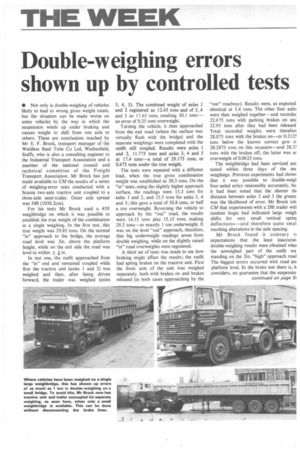Double-weighing errors shown up by controlled tests
Page 50

If you've noticed an error in this article please click here to report it so we can fix it.
• Not only is double-weighing of vehicles likely to lead to wrong gross weight totals, but the situation can be made worse on some vehicles by the way in which the suspension winds up under braking and causes weight to shift from one axle to others. These are conclusions reached by Mr E. F. Brock, transport manager of the Weldless Steel Tube Co Ltd, Wednesfield, Staffs, who is also a consulting engineer to the Industrial Transport Association and a member of the national council and technical committee of the Freight Transport Association. Mr Brock has just made available to CM the results of a series of weighing-error tests conducted with a Scania two-axle tractive unit coupled to a three-axle semi-trailer. Outer axle spread was 34ft (1036.2cm).
For his tests Mr Brock used a 45ft weighbridge on which it was possible to establish the true weight of the combination in a single weighing. In the first test, this true weight was 29.85 tons. On the normal "in" approach to the bridge, the average road level was 2in. above the platform height, while on the exit side the road was level to within + a in.
In test one, the outfit approached from the "in" end and remained coupled while first the tractive unit (axles 1 and 2) was weighed and then, after being driven forward, the trailer was weighed (axles 3, 4, 5). The combined weight of axles 1 and 2 registered as 12.45 tons and of 3, 4 and 5 as 17.65 tons, totalling 30.1 tons— an error of 0.25 tons overweight.
Turning the vehicle, it then approached from the :exit road (where the surface was virtually flush with the bridge) and the separate weighings were completed with the outfit still coupled. Results were axles 1 and 2, 11.775 tons and axles 3, 4 and 5 at 17.4 tons—a total of 29.175 tons, or 0.675 tons under the true weight.
The tests were repeated with a different load, when the true gross combination weight was established as 30.3 tons. On the "in" tests, using the slightly higher approach surface, the readings were 15.3 tons for axles 1 and 2, and 15.5 tons for axles 3, 4 and 5; this gave a total of 30.8 tons, or half a ton overweight. Reversing the vehicle to approach by the "out" road, the results were 14.15 tons plus 15.15 tons, making 29.3 tons—or exactly 1 ton underweight. It was on the level "out" approach, therefore, that big underweight readings arose from double weighing, while on the slightly raised "in" road overweights were registered.
A third set of tests was made to see how braking might affect the results; the outfit had spring brakes on the tractive unit. First the front axle of the unit was weighed separately, both with brakes on and brakes released (in both cases approaching by the "out" roadway). Results were, as expected identical at 5.4 tons. The other four axle; were then weighed together—and recorded 22.675 tons with parking brakes on and 22.95 tons after they had been released Total recorded weights were therefore 28.075 tons with the brakes on—or 0.212f tons below the known correct gcw. o: 28.2875 tons on this occasion—and 28.3f tons with the brakes off; the latter was ar overweight of 0.0625 tons.
The weighbridge had been serviced anc tested within three days of the tes weighings. Previous experiments had showt that it was possible to double-weigl four-axled artics reasonably accurately, bu it had been noted that the shorter th4 distance between axles 2 and 3 the greate. was the likelihood of error. Mr Brock tole CM that experiments with a 28ft trailer witl tandem bogie had indicated large weigh shifts for very small vertical sprinl deflections—and therefore quite smal resulting alterations in the axle spacing.
Mr Brock found it contrary tc expectations that the least inaccurat double-weighing results were obtained whei the unweighed part of the outfit wa standing on the 2in. "high" approach road The biggest errors occurred with road aril platform level. In the brake test there is, h .considers, no guarantee that the suspensio






































































































































































